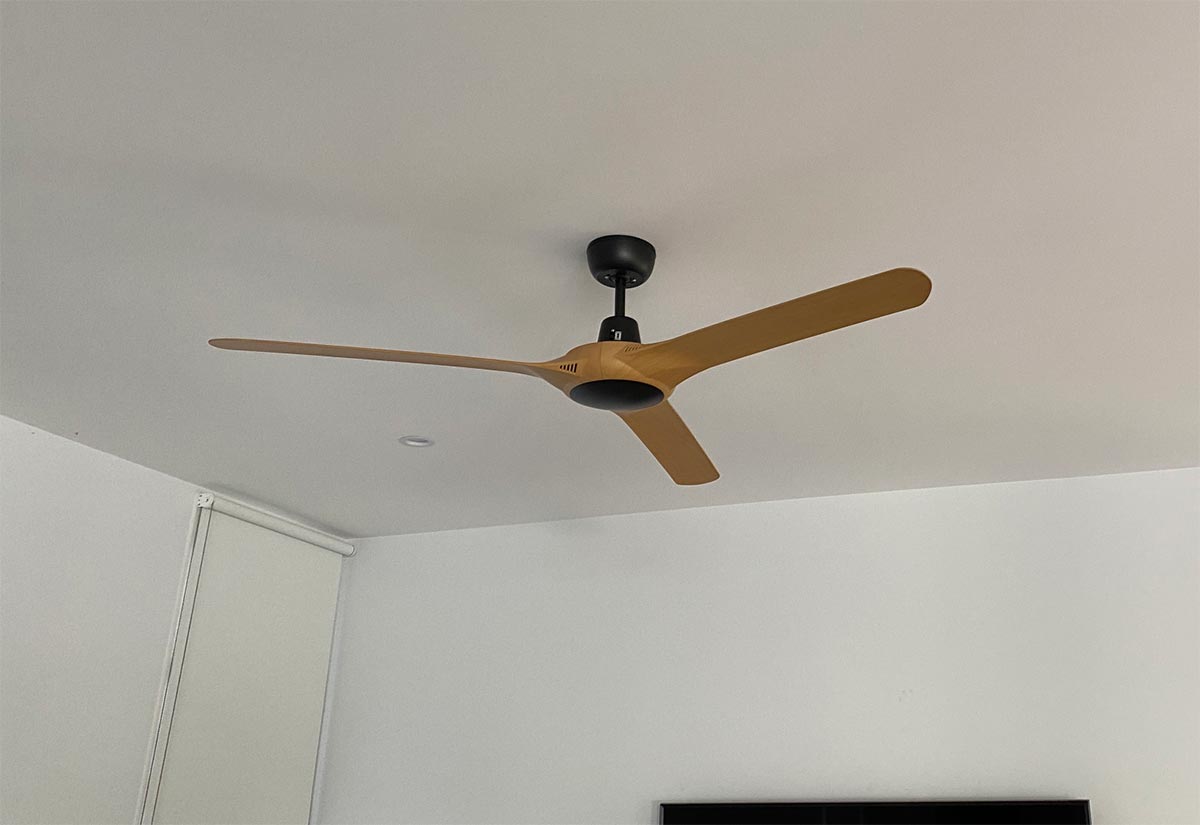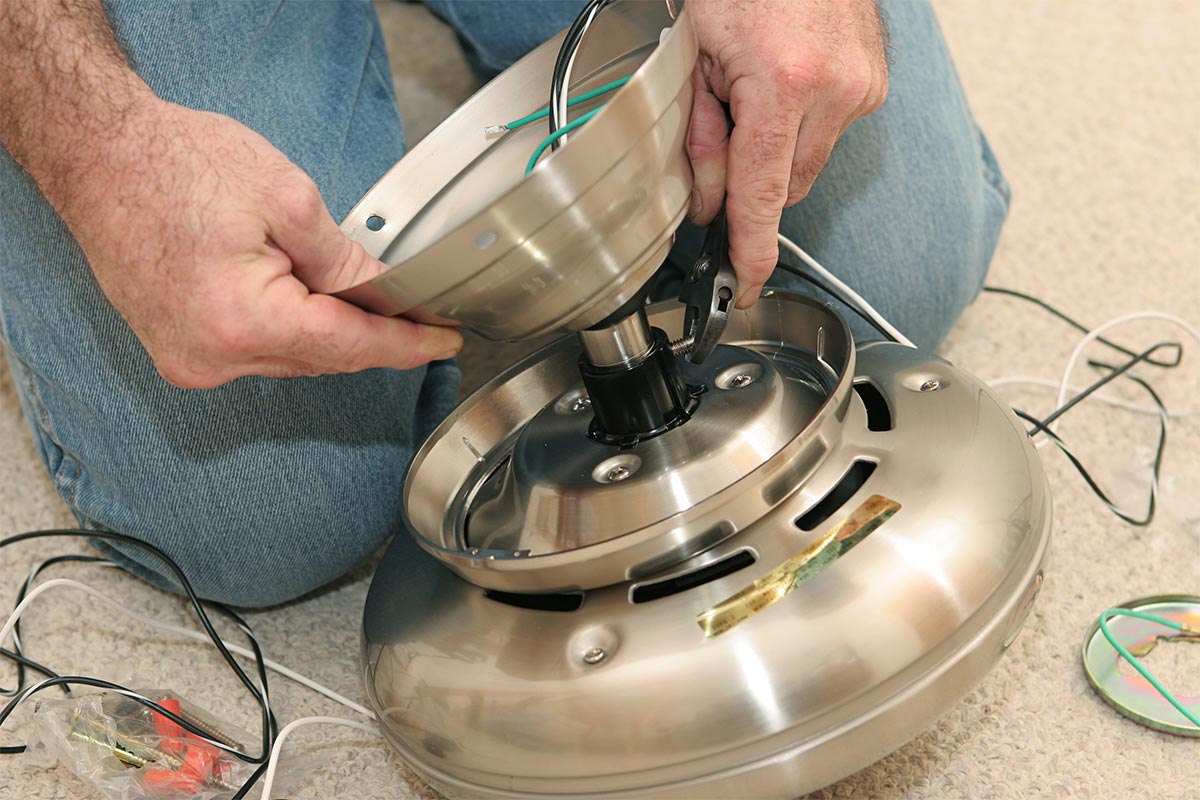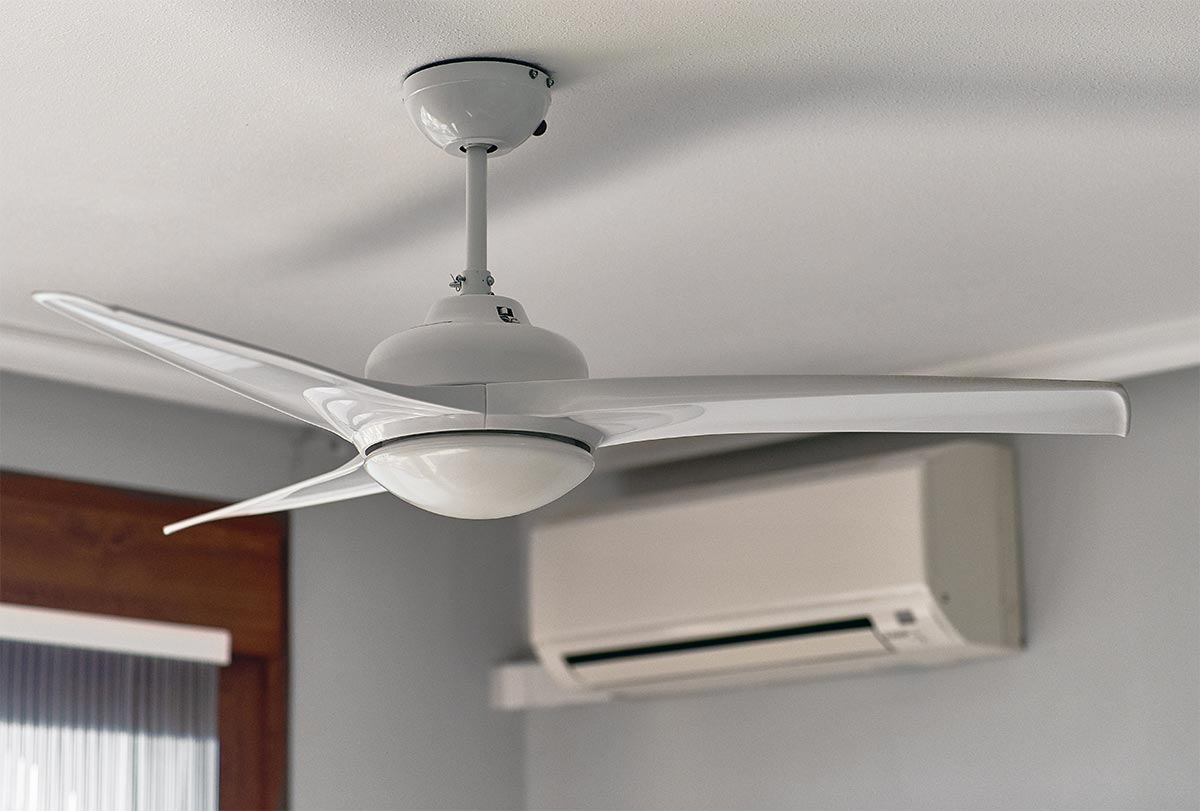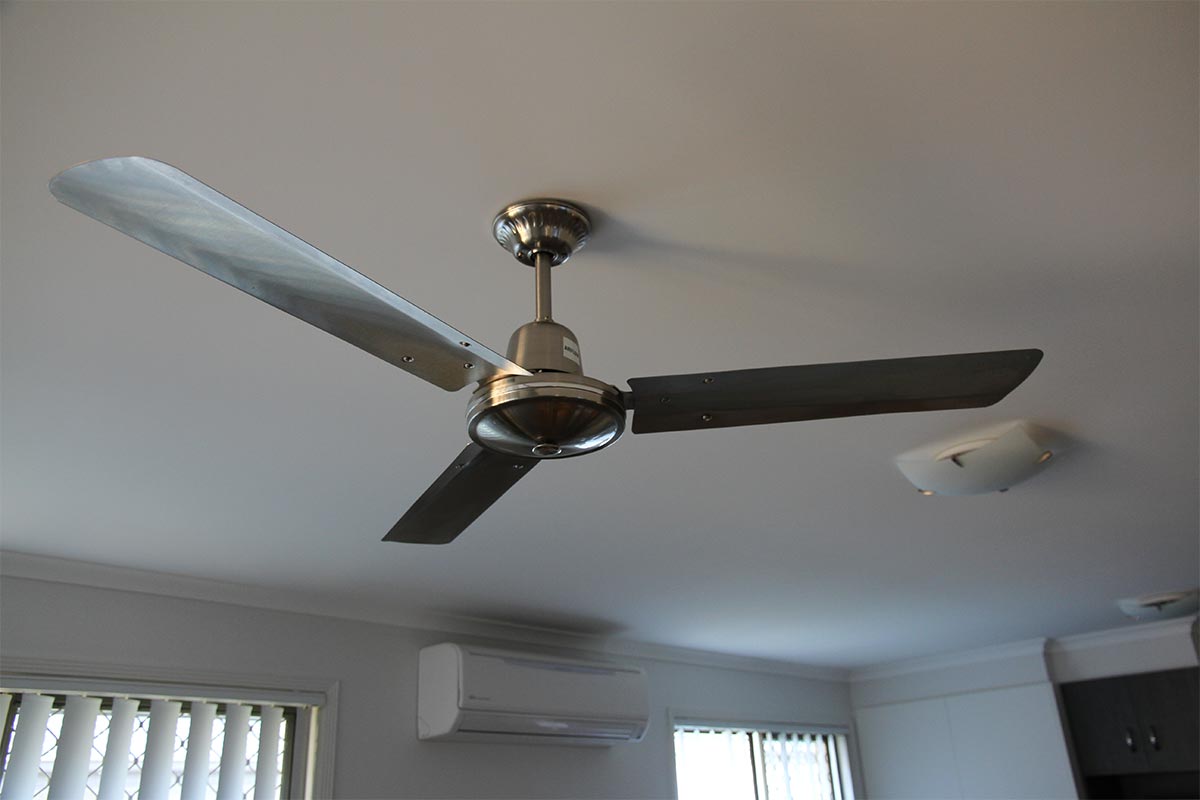LOOKING FOR A CEILING FAN INSTALLER ON THE SUNSHINE COAST?
Sparkies Plus provide ceiling fan installation services to all Sunshine Coast QLD suburbs. With no call out fee, FREE quotes, fixed upfront prices and guaranteed on time arrival, you'll be hard pressed to find a more reliable, professional, local and affordable ceiling fan installation service on the Sunshine Coast.
FREE QUICK QUOTE 🚀
Contact Us
SAVE WITH $0 CALL OUT FEE
ON-TIME ARRIVAL OR WE PAY YOU $50
UPFRONT FIXED PRICING SO THERE'S NO SURPRISES
CEILING FAN INSTALLATION EXPERTS
CEILING FAN INSTALLATION SUNSHINE COAST
It's Summer on the Sunshine Coast. It's stifling hot, and there are zero breezes to speak of. You're on the couch and sweating like the proverbial. You would sell your left kidney right now just to lower the temperature a degree or two! But, your home doesn't have any ceiling fans!! 😳
A ceiling fan is the most efficient way to provide air circulation in a room or house without using an expensive (and often noisy) air conditioner or evaporative cooler. By installing a new ceiling fan, you'll get instant relief due to the movement of air across your skin. And if that isn't enough for you, ceiling fans cost just cents per day to run, last for many years and will also help keep your family comfortable all summer long! And also, waking up with a stuffy nose after you've had the air-con running all night is no fun at all.
But hiring a professional electrician to install your ceiling fan on the Sunshine Coast can be expensive, right?
If you are looking for a way to save time and money with your ceiling fan installations, then hiring Sparkies Plus is the right choice for you! We offer low-cost and professional ceiling fan installation services that will leave you with a cool, comfortable house, lower energy bills and peace of mind. Our electricians have years of experience installing ceiling fans of all makes and models, so hiring us is an easy decision!
We'll take care of your ceiling fan installation from start to finish, from assisting you with choosing the right ceiling fan for your Sunshine Coast home to running the wiring, installing timber support in the ceiling, commissioning and balancing your new ceiling fan, as well as providing you with a few handy tips to get the most out of your new investment.
We have been installing ceiling fans on the Sunshine Coast since 2013, so our experience speaks for itself. We love working with homeowners like yourself who are looking for quality workmanship and affordable prices!
Contact us today to arrange a free quote for your ceiling fan installation at your home or business on the Sunshine Coast. You don't have to worry about any hidden costs or additional fees because we only charge by the job and not by the hour. And remember, when you choose Sparkies Plus, we don't charge a call-out fee to come out and visit you, so it costs you nothing to discuss your ceiling fan installation and leverage our ceiling fan experience.
Sunshine Coast ceiling fan installation
Sparkies Plus carry out ceiling fan installations in the following suburbs on the Sunshine Coast:
Alexandra Headland
Aroona
Battery Hill
Beerburrum
Beerwah
Bells Creek
Birtinya
Bli Bli
Bokarina
Buddina
Buderim
Burnside
Caloundra
Caloundra West
Chevallum
Coes Creek
Coolum Beach
Cotton Tree
Currimundi
Dicky Beach
Diddillibah
Doonan
Dulong
Eerwah Vale
Eudlo
Eumundi
Flaxton
Forest Glen
Glass House Mountains
Glenview
Golden Beach
Highworth
Hunchy
Ilkley
Image Flat
Kenilworth
Kiels Mountain
Kings Beach
Kuluin
Kunda Park
Landsborough
Little Mountain
Maleny
Mapleton
Marcoola
Maroochy River
Maroochydore
Meridan Plains
Minyama
Moffat Beach
Mons
Montville
Mooloolaba
Mooloolah Valley
Mount Coolum
Mountain Creek
Mudjimba
Nambour
Ninderry
Noosa Heads
Noosaville
Pacific Paradise
Palmview
Palmwoods
Parklands
Parrearra
Peachester
Pelican Waters
Peregian Beach
Peregian Springs
Point Arkwright
Rosemount
Shelly Beach
Sippy Downs
Tanawha
Twin Waters
Valdora
Verrierdale
Warana
West Woombye
Weyba Downs
Woombye
Wurtulla
Yandina
Yandina Creek
Yaroomba
OUR CEILING FAN INSTALLATION SERVICES ON THE SUNSHINE COAST QLD
More services across -->>
What is the cost to install a ceiling fan?
The cost of installing a ceiling fan varies due to several site-specific and what specific ceiling fan model you would like installed.
The location of ceiling fan installation is relevant in determining the ceiling fan installation price. For example, ceiling fans installed in ceiling spaces with high ceilings are easier than installations involving low ceilings. Ceiling fans requiring complicated assembly are more expensive to install than quick fit ceiling fans. Remote-controlled fans are often cheaper to install than fans requiring additional wiring.
Generally speaking, though, our ceiling fan installation services are usually between $99 and $389 per fan.
For an accurate ceiling fan installation quote specific to your property, contact Sparkies Plus today.
CEILING FAN FAQ'S
Not sure which ceiling fan to buy? What is the most important things you need to consider when buying a ceiling fan? What ceiling fan brands to we recommend? Find out below!
Which ceiling fan is better 3 blade or 4 blade?
It is a common myth that a four-blade ceiling fan will circulate more air than a three-blade fan. This may not necessarily be the case. The airflow from a ceiling fan is governed by the blade's pitch (the angle of the blade to the horizontal plane) and the speed at which the ceiling fan rotates. We've seen three-blade ceiling fans push more air than many four-blade ceiling fans and, equally, vice versa. Often, the number of ceiling fan blades has no bearing on the airflow of the fan. For an accurate representation of the expected airflow of the ceiling fan you wish to purchase, it is best to consult the manufacturer's specifications related to that model. A ceiling fan's airflow is usually measured in cubic metres per hour (m3/hr), and any fan above 14,000 m3/hr is usually a good choice.
What causes a ceiling fan to wobble?
A ceiling fan can wobble when there's play in the mounting system or components or unbalanced fan blades. In our experience, most ceiling fan wobble issues stem from a loose or poor fixing of the ceiling fan hanging bracket to the ceiling. When the screws supporting the hanging bracket are not fastened tight enough, when a light 7-8 gauge screw is used instead of a 12 gauge roofing screw, or when a screw with a countersunk head is used instead of a flat or pan head, this can be the leading cause of the problem. In other instances, wobble sometimes occurs at the knuckle/ball joint when it is not fixed securely to the down rod. Wherever there is play in a ceiling fan mounting system, ceiling fan wobble is likely. The second contributor to ceiling fan wobble is variances in the weight or alignment of ceiling fan blades. Through some simple checks, Sparkies Plus electricians can diagnose the cause of the ceiling fan wobble and carry out some repairs to dramatically improve the smooth operation of the ceiling fan.
What causes a ceiling fan to make a noise?
A ceiling fan will make noise when excessive wear or wobble exists in the ceiling mounting system, down rod, knuckle or fan blades. Please arrange for Sunshine Coast electrician Sparkies Plus to assess your ceiling fan to determine the cause of the noise and take the necessary steps to make it run like new again.
How can ceiling fans help in cooling a room?
A ceiling fan helps in cooling a room by creating a wind-chill effect. The ceiling fan blades push air downwards as they turn, they move air across the surface of our skin which provides a cooling effect.
Ceiling fans don't actually cool your house, but they do help keep the air moving and freshen up any stagnant zones in a home. When you turn on your ceiling fan, not only are you getting an instant breeze with its associated relief, you're also redistributing the air throughout your home.
Ceiling fans that are appropriately sized and positioned provide a cooling effect on occupants by disrupting the stagnant layer of air surrounding the body, limiting heat loss. A body's heat loss is increased by removing this insulating layer of air, making it feel cooler.
Is it OK to leave ceiling fans on all the time?
If you're in the midst of those stifling hot days of summer, it may seem tempting to leave your home's ceiling fan running for extended periods. After all, when the heat is unbearable, why would you turn your ceiling fans off?
Unfortunately, however, some ceiling fan models can progressively generate more and more heat when run for extended periods, so it can be dangerous to run your ceiling fans continuously. Some ceiling fan models are made for it, other models not so much.
When considering how long you can leave your ceiling fan running without putting the safety of your home at risk, it's crucial to take into account both its size and brand. Each manufacturer has a unique approach when creating their fans; these will dictate whether or not leaving them on for an extended period would be safe in that specific model from that particular company/manufacturer. Please consult the manufacturer's guidelines when determining if it's safe to do so.
As a general rule, it is best not to run your ceiling fan any longer than 8 hours continuously.
Can I install a ceiling fan myself?
No. In Australia, all electrical work must be undertaken by a Licensed Electrical Contractor.
Do you need an electrician to install a ceiling fan?
Yes. A Licensed Electrical Contractor must only carry out any modification to the fixed electrical wiring in a property in Australia.
Is it cheaper to run AC or ceiling fans?
The main benefit of ceiling fans is their extremely low running costs. A traditional AC ceiling fan can cost around 1.8 cents per hour to run. A modern DC ceiling fan can cost approximately 0.5 cents per hour to run. Compare that to a split system air conditioner which can consume anywhere between 25 cents and 97 cents per hour. It makes economic sense to install ceiling fans for cooling benefits in your Sunshine Coast home.
Does a ceiling fan use a lot of electricity?
A traditional AC ceiling fan can cost around 1.8 cents per hour to run. A modern DC ceiling fan can cost around 0.5 cents per hour to run. For example, if you run your DC ceiling fan for 6 hours a day for 5 months of the year, you can expect to pay $4.56 per year in running costs. Not much at all when you consider the fantastic cooling benefits a ceiling fan provides.
What is the lifespan of a ceiling fan?
While most fans are estimated to last for at least ten years, the lifespan of your ceiling fan is going to vary depending on how much you use it and the environment in which it is installed. Ceiling fans in sheltered indoor locations without much use will last far longer than ceiling fans installed outdoors in a coastal environment with regular use. We've seen some fans only last two years before needing replacement, and others 18 years.
What warranties do ceiling fan manufacturers provide?
Ceiling fan manufacturer warranties vary between 1 year and 5 years, and in the case of one manufacturer (Big Ass Fans), their warranty is a lifetime warranty.
With our experience installing ceiling fans on the Sunshine Coast QLD, we've learnt that you generally do get what you pay for when it comes to ceiling fans. Those higher-priced ceiling fans are usually of better quality and longer-lasting than those at the lower price points.
When choosing a ceiling fan based on the manufacturer's warranty, consider whether their warranty terms include the replacement or installation labour.
What are brands of ceiling fans you would recommend?
Based on our experience installing ceiling fans across the Sunshine Coast, we can recommend the following brands:
- Lucci (a brand sold by Beacon Lighting)
- Mercator
- Dekka
- Ventair
- Big Ass Fans (the best quality there is, but expect to pay a premium)
- Hunter Pacific
Please undertake your due diligence and reference genuine customer reviews. However, we've found the brands above to be the most reliable.
Where do I buy ceiling fans on the Sunshine Coast?
Beacon Lighting (they have stores in Minyama and Maroochydore)
Andrews Light Up (located in Maroochydore)
Ideal Electrical (Wises Road, Maroochydore)
The Light House Noosa
Online (numerous online stores)
How much does it cost to run a ceiling fan all night?
An AC ceiling fan running for 10 hours a night will cost on average 19 cents per night.
A DC ceiling fan running for 10 hours a night will cost on average 3.5 cents per night.
What diameter ceiling fan is best?
In years past, the standardised size for a bedroom ceiling fan was 1200mm in diameter. However, lately, the trend is to install a 1320mm ceiling fan in bedrooms. 1400mm diameter ceiling fans are usually reserved for outdoor areas and large lounge or dining rooms. Ceiling fans of more than 1400mm are available for even larger spaces.
With that said, we've installed 1400mm ceiling fans in larger master bedrooms and smaller 1200mm ceiling fans in patio areas.
But, our recommendation is to go with a 1320mm (52") diameter fan in most bedrooms and 1400mm (56") diameter ceiling fans in lounge rooms and entertaining areas.
I want my ceiling fan to move a lot of air but be quiet. Is this possible?
Generally speaking, no. Air movement makes noise. If you wish for a fan that circulates plenty of air, understand that accompanying that will be a level of air movement (whooshing) noise.
We've found a ceiling fan that offers the best of both worlds: the Haiku ceiling fans from Big Ass Fans. They are exceptionally well-engineered and produce an insane amount of air with minimal noise. So, it is possible in a well-designed fan.
What should I look for when buying a ceiling fan?
Build quality. If you want a ceiling fan that lasts, expect to pay more.
Choose a ceiling fan of the right size (1320mm for bedrooms and a minimum 1400mm for larger areas).
Construction materials - for longevity, we recommend choosing the newer fans with polycarbonate blades (otherwise known as plastic or ABS plastic). Polycarbonate ceiling fan blades won't rust, warp, flake, peel, or discolour. We've found many stainless steel fans will still rust on the Sunshine Coast. Timber (MDF or plywood) blade ceiling fans can swell with moisture, warp, delaminate, or the paint can flake off.
Blade pitch - the steeper the blade's pitch, the more air your ceiling fan will circulate.
Height from the ceiling - the minimum legal height of a ceiling fan installed from the ground is 2.1 metres. If you have low ceilings at your Sunshine Coast property, choose a ceiling fan with a short down rod or 'close-to-ceiling design. If you have high ceilings, a fan installed way up in the air won't move much air, and you will be disappointed with its performance. For high ceilings, purchase an accessory for your ceiling fan called an extended down rod (they are generally sold as a 900mm length).
If controlling your ceiling fan wirelessly from anywhere in the room interests you, choose a ceiling fan that comes with (or is compatible with) a remote control.
If you want more fan speeds, choose a DC fan that often has 5-7 different speeds.
When would I need a remote-controlled ceiling fan?
A remote-controlled ceiling fan is required when you have limited to no ceiling space, and you would still like a ceiling fan installed. In these cases, we install a remote-controlled ceiling fan in place of an existing light fitting (and re-purpose the existing wiring for the ceiling fan without running any additional wires).
The second reason why you may want a remote-controlled ceiling fan is when you want to be able to control your fan wirelessly from anywhere in the room or from the comfort of your bed.
What is the best material for a ceiling fan to be made from?
Ceiling fans are generally made of 3 x materials:
Metal (either stainless steel or aluminium)
Timber (either MDF or plywood)
Polycarbonate (otherwise known as polymer, plastic or ABS plastic)
The polycarbonate blade ceiling fans are our recommendation if longevity is important to you. Polycarbonate ceiling fan blades won't rust, warp, flake, peel, or discolour and will undoubtedly last the test of time.
Timber blade ceiling fans often can swell with moisture, warp, delaminate, or the paint can flake off.
Regarding stainless steel fans, you'll be hard-pressed to find a stainless steel fan that doesn't eventually rust here on the Sunshine Coast. We've even installed $500 - $600 stainless steel fans for clients and have discovered that they are rusting 2-3 years later.
Aluminium ceiling fans won't rust. However, they can oxidise and corrode, causing the powder coat to flake off, especially on the leading edge of the fan blade.
Will a ceiling fan fall off the ceiling?
If your ceiling fan has been installed professionally and to the manufacturer's recommendations, no, your ceiling fan is unlikely to come down off the ceiling.
A ceiling fan must be securely fixed to a solid timber (preferably) fixing using 12 gauge roofing screws where possible.
A ceiling fan should never be fixed to a piece of loose timber sitting on top of the plasterboard ceiling, or heaven forbid, just to the plasterboard itself.
If your ceiling fan is beginning to wobble, this may indicate your ceiling fan mounting system needs some attention and tightening up.
What are the disadvantages of a ceiling fan?
A ceiling fan works by moving air across the surface of your skin, so a ceiling fan is generally only effective when it is above you or near you.
Although a ceiling fan can circulate a large proportion of the air in a room (reducing the stagnant air), cooling is only effective when the fan is close to you. Ceiling fans will not lower the temperature of an entire room like air conditioners can.
Which way should my ceiling fan turn in Summer?
When standing underneath your ceiling fan and looking upwards, a fan typically rotates anti-clockwise in Summer, thus pushing air downwards. The part of the blades which angle down should be at the back of the blades.
Which way should my ceiling fan turn in Winter?
When standing underneath your ceiling fan and looking upwards, a fan typically rotates clockwise in Winter, thus pushing air upwards. The part of the blades which angle down should be at the front of the blades.
What is the minimum height a ceiling fan should be installed in Australia?
After installation, the blades of a ceiling fan should be no lower than 2.1 metres from the floor in Australia.












